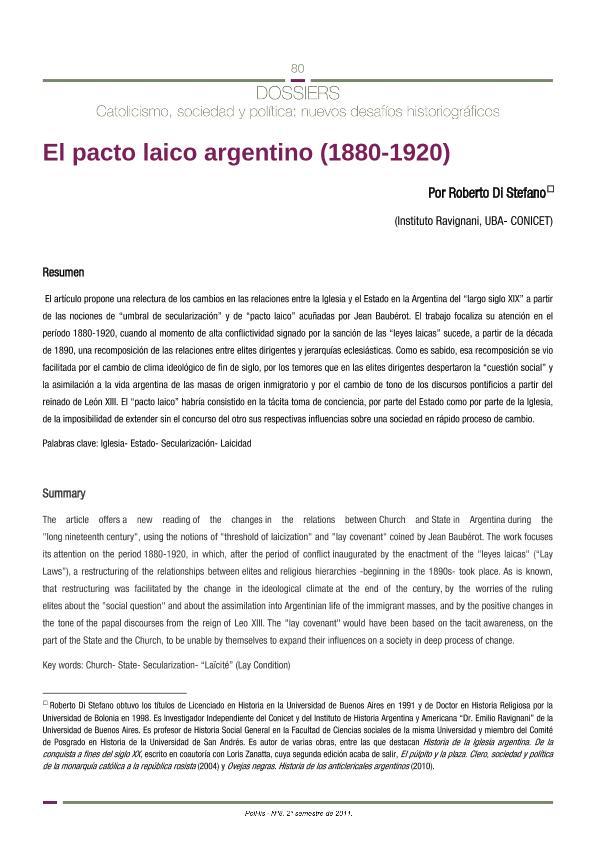Mostrar el registro sencillo del ítem
dc.contributor.author
Di Stefano, Roberto Daniel

dc.date.available
2018-04-19T21:27:42Z
dc.date.issued
2012-08
dc.identifier.citation
Di Stefano, Roberto Daniel; El pacto laico argentino (1880-1920); Programa Buenos Aires de Historia Política; PolHis; 8; 8-2012; 80-89
dc.identifier.issn
1853-7723
dc.identifier.uri
http://hdl.handle.net/11336/42785
dc.description.abstract
El artículo propone una relectura de los cambios en las relaciones entre la Iglesia y el Estado en la Argentina del “largo siglo XIX” a partir de las nociones de “umbral de secularización” y de “pacto laico” acuñadas por Jean Baubérot. El trabajo focaliza su atención en el período 1880-1920, cuando al momento de alta conflictividad signado por la sanción de las “leyes laicas” sucede, a partir de la década de 1890, una recomposición de las relaciones entre elites dirigentes y jerarquías eclesiásticas. Como es sabido, esa recomposición se vio facilitada por el cambio de clima ideológico de fin de siglo, por los temores que en las elites dirigentes despertaron la “cuestión social” y la asimilación a la vida argentina de las masas de origen inmigratorio y por el cambio de tono de los discursos pontificios a partir del reinado de León XIII. El “pacto laico” habría consistido en la tácita toma de conciencia, por parte del Estado como por parte de la Iglesia, de la imposibilidad de extender sin el concurso del otro sus respectivas influencias sobre una sociedad en rápido proceso de cambio.
dc.description.abstract
The article offers a new reading of the changes in the relations between Church and State in Argentina during the "long nineteenth century", using the notions of "threshold of laicization" and "lay covenant" coined by Jean Baubérot. The work focuses its attention on the period 1880-1920, in which, after the period of conflict inaugurated by the enactment of the "leyes laicas" (“Lay Laws”), a restructuring of the relationships between elites and religious hierarchies -beginning in the 1890s- took place. As is known, that restructuring was facilitated by the change in the ideological climate at the end of the century, by the worries of the ruling elites about the "social question" and about the assimilation into Argentinian life of the immigrant masses, and by the positive changes in the tone of the papal discourses from the reign of Leo XIII. The "lay covenant" would have been based on the tacit awareness, on the part of the State and the Church, to be unable by themselves to expand their influences on a society in deep process of change.
dc.format
application/pdf
dc.language.iso
spa
dc.publisher
Programa Buenos Aires de Historia Política
dc.rights
info:eu-repo/semantics/openAccess
dc.rights.uri
https://creativecommons.org/licenses/by-nc-sa/2.5/ar/
dc.subject
Laicidad
dc.subject
Secualrización
dc.subject
Argentina
dc.subject
Siglos Xix-Xx
dc.subject.classification
Historia

dc.subject.classification
Historia y Arqueología

dc.subject.classification
HUMANIDADES

dc.title
El pacto laico argentino (1880-1920)
dc.type
info:eu-repo/semantics/article
dc.type
info:ar-repo/semantics/artículo
dc.type
info:eu-repo/semantics/publishedVersion
dc.date.updated
2018-04-16T14:45:31Z
dc.journal.number
8
dc.journal.pagination
80-89
dc.journal.pais
Argentina

dc.journal.ciudad
Buenos Aires
dc.description.fil
Fil: Di Stefano, Roberto Daniel. Consejo Nacional de Investigaciones Científicas y Técnicas. Oficina de Coordinación Administrativa Saavedra 15. Instituto de Historia Argentina y Americana "Dr. Emilio Ravignani". Universidad de Buenos Aires. Facultad de Filosofía y Letras. Instituto de Historia Argentina y Americana "Dr. Emilio Ravignani"; Argentina
dc.journal.title
PolHis
dc.relation.alternativeid
info:eu-repo/semantics/altIdentifier/url/http://historiapolitica.com/datos/boletin/polhis8_DiSTEFANO.pdf
Archivos asociados
